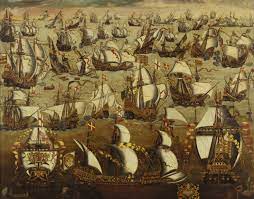
Sapiens
In his magisterial book ‘Sapiens’ (2011) the Israeli historian Harari sets out to cover the whole of human history. The crucial period was the Cognitive Revolution of 70,000 to 30,000 BCE. Suddenly (in a geological sense) Homo Sapiens was able to co-operate in combinations much larger than the small face-to-face groups our hunter-gatherer ancestors had managed hitherto. Suddenly whole tribes, town and ultimately cities became possible. How did we do this? Through inventing stories.
Peugeot

Harari’s classic example is the French car company Peugeot SA. In 1896 Armand Peugeot took steps in accordance with the French legal system to create the company Peugeot SA as a new legal entity. No one doubts the existence of the Peugeot company, but it would still survive if all the factories, offices and employees were lost in some catastrophe. It could still survive and start trading again. ‘dIf somehow we convince millions of people to believe particular stories about gods , or nations, or limited liability companies, (then) it enables millions of strangers to cooperate and work towards common goals…An imagined reality (such as money) is something that everyone believes in, and as long as the communal belief persists, the imagined reality exerts force in the world’. It would only disappear if we all stopped believing in limited liability companies.
Understanding ourselves
Stories are crucial because it is how we understand ourselves and our lives. My father wrote an account of his life. It started in Germany, he came to England in 1933 because of Hitler and studied medicine. He married Mum in the war. Later in 1960 he worked for two years in Uganda and I went out for the longer holidays. In 1963 we went on holiday to Munich at the invitation of the City Council – a very healing experience. Lots of stories which help to make me the person I am.
The same holds true for societies. It is not surprising that the teaching of history in schools should become a political battleground. Conservatives champion the telling of great moments in our nation history such as the defeat of the Spanish Armada in 1588. Left-wing parties maintain we should use history to include the various cultures which make their home here and to appreciate that we live in an inter-connected world; history should be about justice and compassion, so the trans-Atlantic slave trade would be key.
Not so harmless
Normally stories are relatively harmless. But they can be weaponised. The book ‘The Protocols of the Elders of Zion’ described a Jewish plan for global domination. It was published in Russia in 1903 and became a worldwide phenomenon in the 1920’s, despite proof that they were forgeries. Hitler promoted it and it led directly to the Holocaust and the murder of some 6 million Jews. Right now we see how Putin is proclaiming that his military intervention in Ukraine is to rescue the poor subjugated Ukrainians for evil Neo-Nazis, of whom the Jewish Zemlensky is a prime exponent (!) Sadly stories do not have to be true to have a disastrous impact. It is enough for them to create hatred between people and so spark off violence, as we saw in Rwanda, Zimbabwe, former Yugoslavia etc. It may be that 100,000 years ago Home Sapiens acted just this way when they came across groups of Neanderthal and other humans. Maybe genocide is in our genes, and it only needs a good dramatic story to set it off.

Of course, stories can also do good, they can encourage mutual help and understanding between different people groups., as in Jesus’ parable of the Good Samaritan.
A good example of how stories work is seen in the statue of Edith Cavell just north of Trafalgar Square.. Cavell was an English nurse in Belgium when Germany invaded in 1914. She treated wounded from both sides, and helped to smuggle 200 British soldiers to neutral Holland. She was arrested and shot. In 1920 the Liberal-Conservative Coalition government put up the very large monument with the rather jingoistic inscription “For King and Country”. When Ramsay MacDonald formed the first Labour government in 1924 a further inscription was squeezed in with the actual words Edith Cavell wrote just before her death: “Patriotism is not enough. I must have no hatred or bitterness to anyone.” Which to choose?
How stories work
The story of Edith Cavell illustrates perfectly how stories work. Here is a diagram:
What happened ➡︎ The story ➡︎ a meaning
The facts of what happened to Miss Cavell are clear and undisputed.
The story could be told to highlight Edith’s heroism and Christian faith; or to denounce the brutality of the German occupation forces and the need for patriotic soldiering. You pays your money and you takes your choice,

The same goes for the story of the Spanish Armada in 1588. It was perhaps the largest military force the world had seen. And yet it failed, partly though bad decisions of the Spanish commander, partly though atrocious weather. What did the defeat of Spain’s ‘Great Enterprise’ mean?
The English were clear. God intervened by sending just the wrong sort of weather for the Spanish fleet at the right time. God was on our side.
The Spanish were equally clear. The English seamen were better than the Spanish ones. Anything so as not to say that God was against them.
The facts were the same, the stories not dissimilar, the meanings quite different.
The Birth of Religions
Religions are large communities combining million, sometimes billions, of adherents. It is stories which glues these communities together. It may be that only a small minority of adherents study them ‘religiously’. For the majority it is likely that these stories are more like a passive background to their lives. Here are some of the founding stories:
Ancient Greece. The two great poems of Homer, the Iliad and the Odyssey, were the backbone of how Greeks understood their place in the universe. They are essentially accounts of human actions, but with divine forces at work.
Hinduism. The Mahabarata tells of a civil war happening about 900 BCE, and formed into the longest poem in the world between 500 and 1,00 years later. It includes the devotional book of the Bhagavad Gita in which Krishna tells the prince Arjuna how to work and love and live.
Buddhism. The foundation story is of a young prince Gautama left the palace to seek the answer to suffering. He discovered the principle of non-attachment, the basic Buddhist view of life and salvation.
Judaism. Judaism proclaims a God who is beyond the universe and yet is active in history, specially in the escape of the Hebrew slaves from Egypt, perhaps about 1200 BCE. The story us told and reflected on in the first part of the Bible, which Jesus called the Law and the Prophets.
Christianity. The Christian message is centred on Jesus, primarily on the impact which his death and resurrection had on people then and still has on people now.
Islam In 610 CE Mohammed received his first vision of God/Allah. There were subsequent revelations as set out in the Our’an. Because God spoke to Mohammed in Arabic, the actual text of the Qur’an is in Arabic, they are the words of God. Adherents are commanded to pray five time a day and to complete once the pilgrimage to Mecca.
Finding Meaning
But the bare stories are not the whole of it. Recall the diagram:
What happened ➡︎ The story ➡︎ a meaning
The stories will have some relationship with actual events, in the Mahabharata’s case, minimal, in the New Testament’s case quite fundamental. But the stories are what we have and what people revere. Their significance goes far beyond the actual stories. They enshrine their own linguistic ‘game’, to use the Austrian philosopher Wittgenstein’s word. A ‘game’ is the whole context, usage and grammar in which words are used, and you cannot use another ‘game’ without falling into nonsense. One example he gave was one of his experiences as a soldier in the First World War. A consecrated ‘host’ or bread was brought to give communion to troops in the front line. It was protected by a bullet-proof steel case. Mysticism meets military hardware! Faith encased by fear.
St Paul & Communion
We have a prime example of stories providing meaning in a letter of St Paul. In 1 Corinthians 11 he says: I received from the Lord what I also handed on to you, that the Lord Jesus on the night when he was betrayed took a loaf of bread, and when he had given thanks, he broke it and said, ‘This is my body that is for you. Do this in remembrance of me.’ In the same way he took the cup also, after supper, saying, ‘This cup is the new covenant in my blood. Do this, as often as you drink it, in remembrance of me.’

Here is a story that explicitly goes back to actual events – in fact probably the earliest account we have of the Last Supper. What point is Paul making?
First, to talk about the death of the Messiah as the central paradox if the new Jesus community. For as often as you eat this bread and drink the cup, you proclaim the Lord’s death until he comes.
Second, wealthier members of the local fellowship should stop bringing their own private food to the common sacred meals. Everyone should be treated with respect, whether rich or poor: When you come together, it is not really to eat the Lord’s supper. For when the time comes to eat, each of you goes ahead with your own supper, and one goes hungry and another becomes drunk. What! Do you not have homes to eat and drink in? Or do you show contempt for the church of God and humiliate those who have nothing?
Third, discern the body, whatever that means!
Fifteen hundred years later the meaning had grown more elaborate. Thomas Cranmer, in his exhortation in the 1552 Book of Common Prayer said: Then we spiritually eat the flesh of Christ and drink his blood; then we dwell in Christ, and Christ in us; we are one with Christ, and Christ with us.
We have come quite a long way from “Do this in remembrance of me.” But that’s stories for you.
